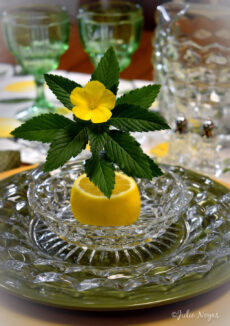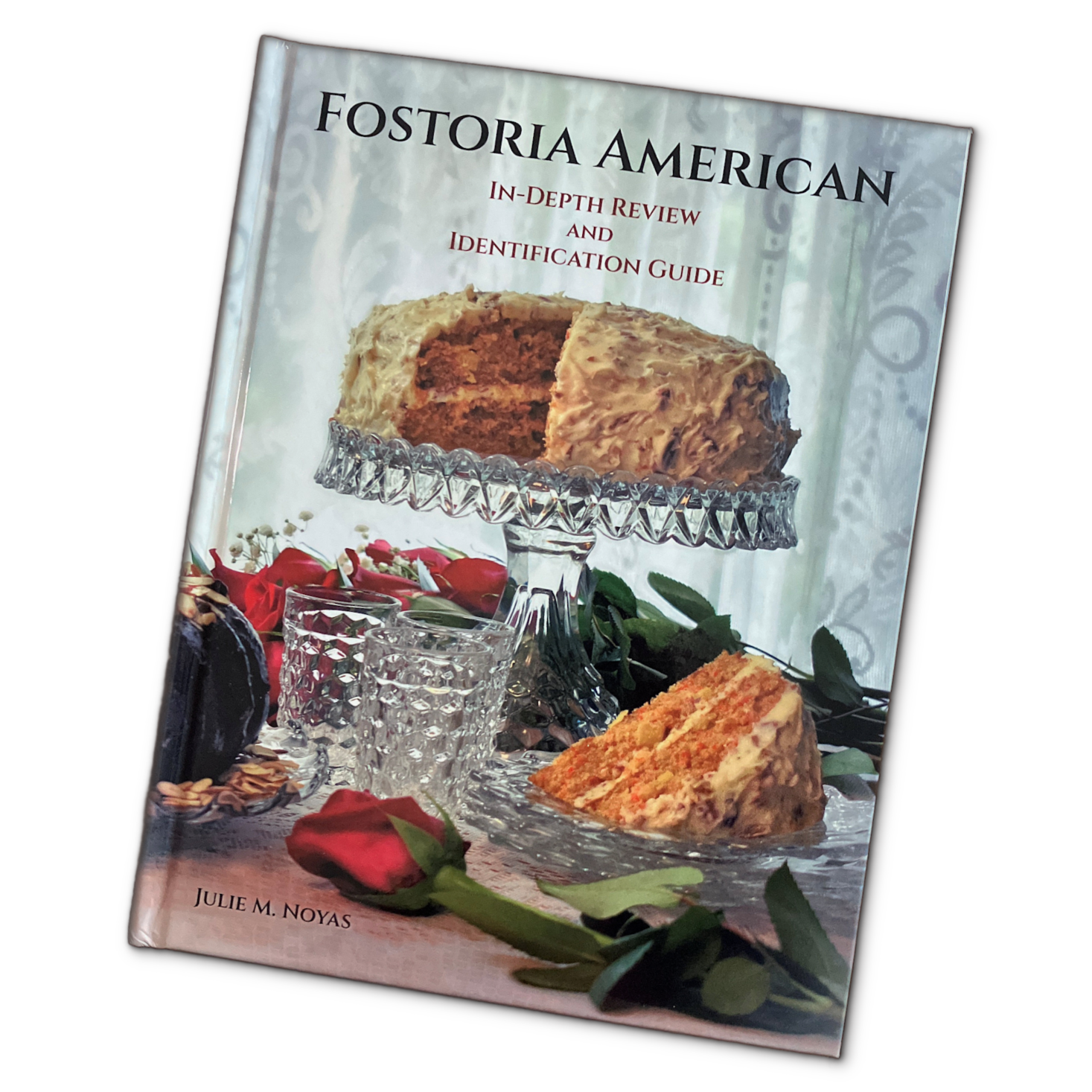by Julie Noyas | Dec 20, 2024 | Uncovered Version
Item Number: 462-NC
Approximate Size: 5½″ D; 1⅝″ H
Production Dates: 1915-1944
 Many people think that the Lemon Dish was always offered with a cover. That simply is not true. Fostoria Glass offered this piece with, or without, a cover. This post is in regards to just the Lemon Dish, without a cover. This item was introduced in 1915 and produced for many years thereafter. It was offered without a cover through 1944; however, when the Lemon Dish was reintroduced in 1947, it was only available with a cover.
Many people think that the Lemon Dish was always offered with a cover. That simply is not true. Fostoria Glass offered this piece with, or without, a cover. This post is in regards to just the Lemon Dish, without a cover. This item was introduced in 1915 and produced for many years thereafter. It was offered without a cover through 1944; however, when the Lemon Dish was reintroduced in 1947, it was only available with a cover.
Without a cover, the Lemon Dish stands about 1⅝″ tall (measured to the top of the handle). This lovely dish can be used for a multitude of purposes – such as a candy, confection and/or a relish dish. I often use it as a unique vase, holding a flower that has been embedded into a lemon wedge. It smells divine, and is always a show-stopper!
As an eBay Partner, I may be compensated if you make a purchase on eBay. The following link shows available Lemon Dishes on eBay.
by Julie Noyas | Aug 27, 2024 | Covered Containers
Item Number: SV-05
Approximate Size: 5¼″ H – 8 oz.
Production Dates: 1938-1944
The Syrup & Cover was introduced in 1938, towards the end of the art-deco period. At the time, a consumer could also purchase the Syrup, Cover, and 6″ Syrup Plate together, as a 3-piece unit. The Syrup Plate (P-04) is also shown in the Plates, Saucers, Tortes, & Tid Bits section of this website.
The catalog data states that the Syrup is about 3¾″ high; however, that measurement is only accurate when measuring the Syrup without the Cover. Since the Syrup & Cover was never sold without the top, the measurement I have stated above (5¼″) is referencing the height of the Syrup with the Cover on. The holding capacity of 10 ounces was also inaccurate in the catalog data. A more accurate holding capacity would be approximately 8 ounces, which I have disclosed above.
As an eBay Partner, I may be compensated if you make a purchase on eBay. The following link shows available Syrup Servers on eBay.
by Julie Noyas | Jul 24, 2024 | Covered Containers
Item Number: CC-13
Approximate Size: 5¾” D; 10″ H
Production Dates: 1915-1925
The Crushed Fruit & Cover debuted in 1915, at the same time the Cracker Jar & Cover (362) was introduced. The Crushed Fruit & Cover was only produced for about a decade, making it an item that is highly sought-after.
With the Cover on, the Crushed Fruit has a height of about 10-inches. The special design of the Crushed Fruit Cover has a hollow area in the top handle, which allows space for the Crushed Fruit Spoon to rest. Finding any of the Crushed Fruit parts without damage is always a great find!
As an eBay Partner, I may be compensated if you make a purchase on eBay. If you are interested in purchasing a similar piece, please click the following sponsored link for available Crushed Fruits on eBay. These are items that are not found with great ease, so please be patient as there might be few (if any) in the search results.
These are items that are not found with great ease, so please be patient as there might be few (if any) in the search results.
by Julie Noyas | Nov 9, 2021 | Covered Containers
Item Number: 676
Height: 6¼”
Production Dates: 1915-1982
As an eBay Partner, I may be compensated if you make a purchase on eBay. The following link shows available Candy Jar & Covers on eBay. Since people sometimes refer to this item by different names, you might need to modify your search terms accordingly.
Since people sometimes refer to this item by different names, you might need to modify your search terms accordingly.
by Julie Noyas | Oct 11, 2021 | Covered Containers
Item Number: CC-14
Approximate Size: 4″ Top D – 12″ H
Production Dates: 1915-1928
The main body of the Straw Jar was produced from the same glass mould as the 10″ Vase. The two items are often confused with each other. Though made from the same mould, the Straw Jar bottom was made with a bigger opening so that it could accommodate a cover (or lid). If one tried to put a Straw Jar Cover on a piece that was designed to be a 10″ Vase, it would not fit. The lid would be too big, as the 10″ Vase has a smaller opening in comparison to the Straw Jar.
The Cover is the same piece that is used as the lid for the Sugar and Cover. This information is good to know, especially if you only have the bottom to the Straw Jar – and are in need of just a cover.
As an eBay Partner, I may be compensated if you make a purchase on eBay. The following link shows available Straw Jars on eBay.
by Julie Noyas | Oct 7, 2021 | Covered Containers
Item Number: SV-02
Approximate Size: 6¾” H – 11 oz.
Production Dates: 1915-1925
This lovely, and very old piece, makes a grand impression on the table. The Molasses Can made its debut in 1915. It was only produced for about ten years, and during that time, different variations of the top were offered. The tops most often showcased a thumb piece design. The thumb piece either featured a shell design, or it was plain – with a thin outline. Other types of tops have also been seen; however, I have not seen those illustrated in any of the early Fostoria American catalogs.
The lid components of the Molasses Can were made out of an alloy called Zamak (or Zamac). The tops were also produced in sheet metal, which is not as strong, or thick, as Zamak. The sheet metal lids are typically stamped “Patent Pending” inside. No matter the material that was used in production, all of them were plated with a layer of metal – typically nickel. The nickel plating helped with wear and corrosion resistance. Fostoria even used the initials E.N.T. (Ewer Nickel Top) in the item’s description to reflect that nickel was used.
Another type of server that was also produced during the 1915 timeframe is the Syrup with a Metal Handle. Both of these servers are exquisite pieces from the American pattern. As an eBay Partner, I may be compensated if you make a purchase on eBay. The following link shows available Molasses Cans on eBay. The results will probably be limited; however, they do show up for sale every now and again.
The results will probably be limited; however, they do show up for sale every now and again.
 Many people think that the Lemon Dish was always offered with a cover. That simply is not true. Fostoria Glass offered this piece with, or without, a cover. This post is in regards to just the Lemon Dish, without a cover. This item was introduced in 1915 and produced for many years thereafter. It was offered without a cover through 1944; however, when the Lemon Dish was reintroduced in 1947, it was only available with a cover.
Many people think that the Lemon Dish was always offered with a cover. That simply is not true. Fostoria Glass offered this piece with, or without, a cover. This post is in regards to just the Lemon Dish, without a cover. This item was introduced in 1915 and produced for many years thereafter. It was offered without a cover through 1944; however, when the Lemon Dish was reintroduced in 1947, it was only available with a cover.
